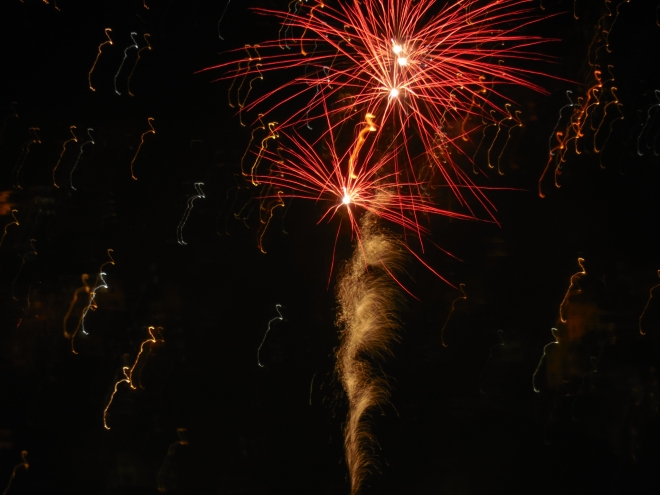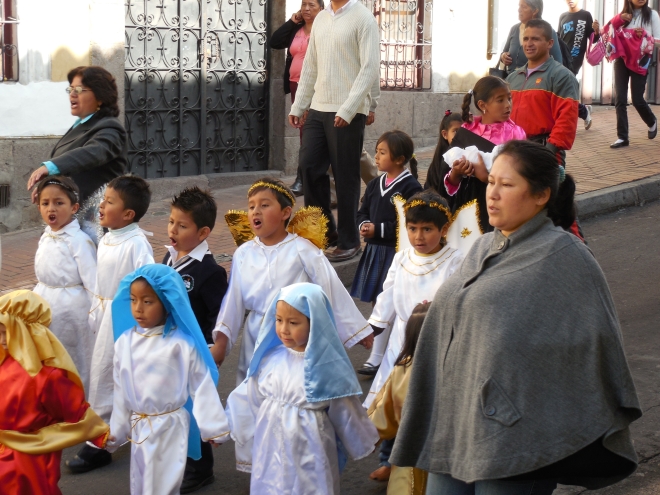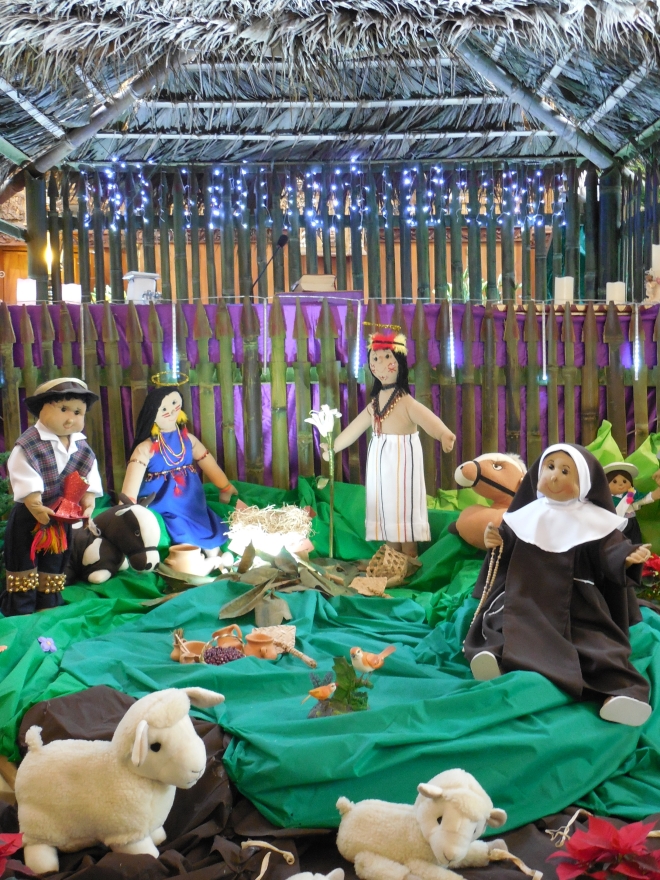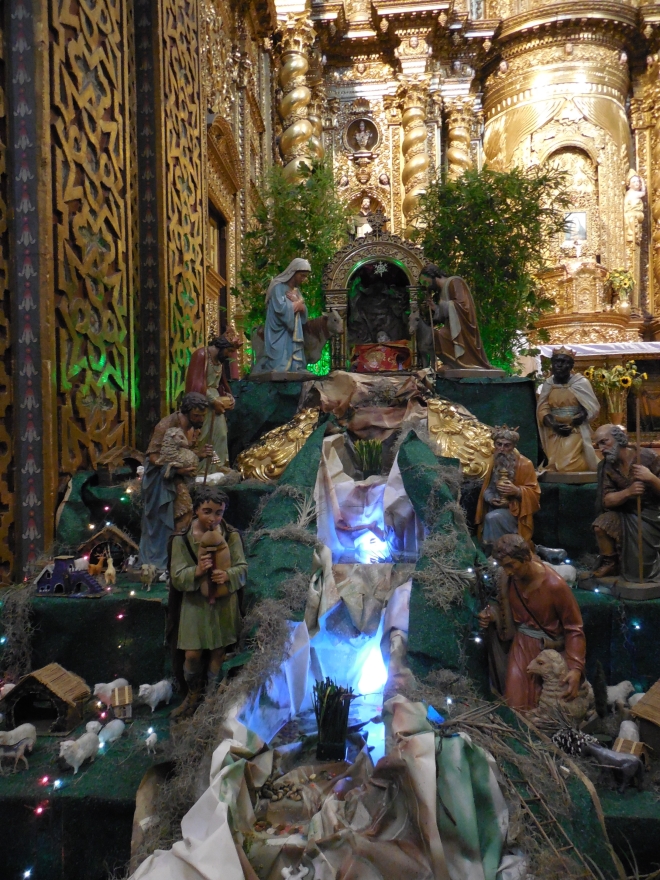
At the stroke of midnight, eat one grape at each toll, making a wish of what you desire the New Year to bring you.
©Lorraine Caputo
Tonight, as this old year ends, people will be celebrating throughout Latin America. Fireworks burst across the midnight sky, and twelve grapes are eaten with each stroke of that hour, to bring twelve wishes to fruition. Viejos (Old Man Year) are set afire, finally exploding into a million sparks shooting into the new year. Food and liquor flow into the wee hours.

One of Latin America’s most common New Year Eve traditions is the Old Man Years, often representing politicians, sports stars or other people in the news. photo © Lorraine Caputo
The most explosive of the customs is the Años Viejos (Old Man Years). These effigies represent politicians, sports figures, entertainment celebrities or other famous persons. At midnight on New Year’s Eve, they are dragged to the middle of the street and lit ablaze. Once the flames reach the center of the effigy, the fireworks stuffing explodes.
Some Latin American neighborhoods have contests for the best one, in which civilians and public services, like the bomberos (fire department) will participate. In Ecuador, the end-of-year custom also includes displays summarizing the year’s events in political, sporting and other arenas. Often Años Viejos are accompanied with a testamento, a word of advice or with a list of the things to be burned before the New Year begins.

Colombians believe that a sheaf of wheat placed in your home brings abundant food and prosperity in the New Year. ©Lorraine Caputo
Colombia has a bevy of traditions (agüeros) not practiced in other parts of Latin America. They believe that a sheath of wheat placed in your home brings abundant food and prosperity in the New Year. At the stroke of midnight, Colombians will walk the block with a suitcase (to bring lots of travel in the next year), count money over and again (to make it multiply), or take a champagne bath (to ensure good fortune and prosperity). They also have a number of other ways to draw wealth, good luck — and even divine the future year.
One custom that Colombia shares with its southern neighbor, Ecuador, is wearing yellow underwear to draw good vibes. Red will fulfill passionate desires.
But besides the fireworks and the Viejos, that equatorial country seems to have something all its own: the Viudas Alegres, or the Merry Widows. Ecuadorian men dress up as women and joyfully greet all on the streets. Why do the men do this? Some state that these are the Merry Widows of Old Man Year, so happy to see him finally gone and done with. Others say, to disguise themselves from the problems of the old year, so those troubles don’t follow them into the New Year. But you’ll see everyone, man and woman, child and adult, dressing up. Quito’s Centro Histórico streets are crowded with vendors selling everything from cheap, florescent wigs to pointy witches’ hats.

The perfect eyelashes to go along with your new hair-do. You may also pick up shimmering, pointy witches’ hats, and an array of body parts: breasts, tushes, and aprons covering the (ahem) nether regions. ©Lorraine Caputo
Another Ecuadorian custom is to have a baño – or spiritual bath, to cleanse oneself of negative energies. Business owners also sweep their stores clean, from back rooms to the front door, with brooms made of eucalyptus, rue, chamomile and other herbs, then lock the shop up tight until the New Year.
Since 1988, I have spent most northern winters travelling in Latin America. I have rung in the New Year in large cities and small towns in Mexico, Cuba, Honduras, Nicaragua, Colombia, Ecuador, Peru, Chile and Argentina.
One scene that stays with me – that I have never witnessed before or since – are the fireworks in Santiago de Chile: The burst formed one giant blue heart, from which emerged another blue heart and yet another and yet another … Such a beautiful way to end a night of feasting, drinking and bottle dancing in the middle of a street at a block party.
In Trujillo (Honduras), like everyone else, I dodged the Bárbaro. This Garífuna custom involves a bare-chested man dressed in a grass mini-skirt, covered in rouge or grease, demanding spare change from all on the street. (The money is used for community parties and projects.) If you don’t give him even a mere centavito, he will give you a big bear hug – thus covering you with grease (or rouge).
In Havana, I spent the night with Cubans, eating and dancing to the world’s best music. At the midnight hour, the national anthem played, everyone singing along, to mark another year of the Revolution. (Yes, that scene from the Godfather II is true: At the stroke of midnight, dictator Fulgencio Batista announced he was throwing in the towel and, loaded down with millions of dollars in cash, art and jewels, boarded a plane into exile, thus handing victory over to the guerrilleros after their decisive victory in Santa Clara, under the command of Ernesto “Che” Guevara.)
In Bucaramanga (Colombia), at the invitation of the hostels’ family, I lit a candle for my next year. In Puerto Ayora, Galápagos (Ecuador), I saw the beauty pageant, in which those lovely Viudas Alegres showed off their talents, modeling and answering “probing” questions.
In Mexico, I pondered what the New Year would bring to a world on the brink of war. In Ecuador, I watched a Syrian refugee immerse himself in the local customs.
Today, let us poetically journey to these celebrations and ponderings.
May the New Year be full of Light, and wishes come true.
Safe Journeys!
WELCOMING THE NEW YEAR
(Colombia)
Midnight approaches
without a
bell toll
Already rockets burst
in green & white
in a red heart
against a sooty sky
The old men are dragged
to the streets
& at that hour
they are burnt
firework stuffing
exploding
& we eat grapes, one
by one
Gabriel counts his money
over & again
Rice is thrown, scattering
in the still air
Someone walks around a block
suitcase in hand
To welcome in a
better year
published in:
The Blue Hour (1 January 2013)
NEW YEAR’S TRIPTYCH
(Mexico)
I.
Outside the empty
streets echo
with blasts of fireworks
To scare away the demons
that lurk in the shadows
of time a’changing
& within this silent house
my mind echoes
Scare away those demons
of war, hunger, disease
Scare away those demons
of misery & poverty
Scare away those demons
of corporate greed
that is destroying this planet
II.
At midnight
the streets fall silent
I eat a grape
at each stroke of the hour
& wish
May there be no war
& wish
May there be peace on earth
& then
more cracks to scare
the last demons away
III.
Come dawn
the smell of a fire
creeps along the
abandoned streets
A police car’s red-blue-red-blue-
yellow lights silently
reflect off windows
Standing in the
ochre fog that slithers
past sleeping homes
& closed shops
I look for an answer
of what this new year
may hold
published in:
The Blue Hour (1 January 2013)
DANCE FOR A NEW YEAR
(Ecuador)
The near-midnight streets
are littered with
the frenzied sales of this day
Someone sweeps them
into large piles
& sets them ablaze
On one corner a family sits
drinking to music
& the man in the bright pink wig dances
On corners
& midways down blocks
the Merry Widows of this dying year
stop cars for coins
dancing, lying atop hoods
& the man in the bright pink wig dances
On stages decked with eucalyptus
Old Man Years slump in plastic chairs
a DJ spins, a young woman sings
& the man in the bright pink wig
dances with abandon
The midnight hour
the Old Men are dragged to
the center of those cobblestone streets
gasoline poured & set afire
& the man in the bright pink wig
dances with frenzy
As far as the streets climb
steeply up, the fires blaze, fireworks
explode
& the man in the bright pink wig
frantically dances
to forget he cannot go home
to his war-rent country
his family cannot get out
his uncle dies of poisoned water
a wife to be found, a family to be formed
Heavy smoke filled the narrow streets
stinging eyes, burning lungs
creeping past shuttered shops
creeping past the migrant indigenous
families come to the city for work
round dancing to Andean cumbia
& the man in the bright pink wig
dances, dances
published in:
Prachya Review (Bangladesh) (Summer 2016)
MIDNIGHT TOLL
(Ecuador)
Even before those
midnight bells ring
This valley resounds with the explosion, the sizzle of fireworks spiraling green, white, red sparks against the yellow-light speckled hills.
The Old Men are dragged to the streets & set afire. Eager to see this year ended, people leap over the flames, beckoning luck to come.
Yet I await that
new year hour to toll
Awaiting to embrace my future dreams
bursting, sizzling before
The fireworks die … fading. Silence fills the streets. Music of distant parties throbs in the land’s crimps.
The smoke of Old Man Year’s fires & of the fireworks lowers with the silence, mingling with the clouds lowering, obscuring this valley’s slopes.
poem © Lorraine Caputo























